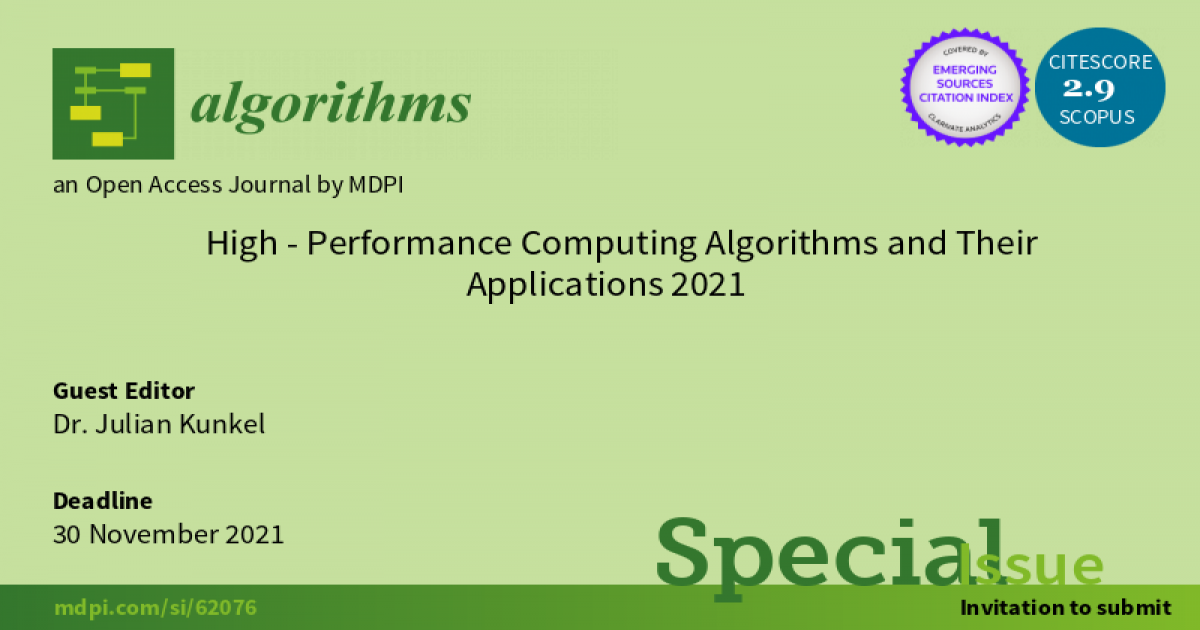High-Performance Computing Algorithms and Their Applications 2021
A special issue of Algorithms (ISSN 1999-4893).
Deadline for manuscript submissions: closed (30 November 2021) | Viewed by 9705

Special Issue Editor
Special Issue Information
Dear Colleagues,
Scalable parallel applications are an enabler of research and development in science and industry. For example, they allow us to predict the impacts of diseases, weather, or earthquakes on society, they enable the discovery of products such as drugs or constructions like a fusion reactor. The fundamental methods and algorithms evolve with the demand in the applications and the capabilities of hardware and software environments to execute them. On the horizon are revolutionary changes to the landscape of applications -- machine learning and quantum computing are being integrated into traditional HPC and large-scale workflows span across a single data center to the cloud, fog, and edge. At the same time, numerical algorithms, e.g., for particle and mesh-based simulations are evolving.
This special issue aims to provide an overview of the research frontiers of parallel algorithms and their application in science and industry. We invite you to submit high-quality papers to this Special Issue “High-Performance Computing Algorithms and their Applications” covering the whole spectrum of application domains: Astronomy, Biosciences, Digital humanities, Geoinformatics, ... A submitted manuscript should describe the application domain, the principles of the algorithms that address the problem, and state-of-the-art on the field. The following is a (non-exhaustive) list of algorithms of interest:
- Particle and mesh-based simulations
- Machine learning methods (in HPC)
- Quantum algorithms
- Applied numerical methods
- Spectral methods
- Algebra problems
- Monte Carlo methods
Dr. Julian Kunkel
Guest Editor
Manuscript Submission Information
Manuscripts should be submitted online at www.mdpi.com by registering and logging in to this website. Once you are registered, click here to go to the submission form. Manuscripts can be submitted until the deadline. All submissions that pass pre-check are peer-reviewed. Accepted papers will be published continuously in the journal (as soon as accepted) and will be listed together on the special issue website. Research articles, review articles as well as short communications are invited. For planned papers, a title and short abstract (about 100 words) can be sent to the Editorial Office for announcement on this website.
Submitted manuscripts should not have been published previously, nor be under consideration for publication elsewhere (except conference proceedings papers). All manuscripts are thoroughly refereed through a single-blind peer-review process. A guide for authors and other relevant information for submission of manuscripts is available on the Instructions for Authors page. Algorithms is an international peer-reviewed open access monthly journal published by MDPI.
Please visit the Instructions for Authors page before submitting a manuscript. The Article Processing Charge (APC) for publication in this open access journal is 1600 CHF (Swiss Francs). Submitted papers should be well formatted and use good English. Authors may use MDPI's English editing service prior to publication or during author revisions.
Keywords
- Particle and mesh-based simulations
- Machine learning methods (in HPC)
- Quantum algorithms
- Applied numerical methods
- Spectral methods
- Algebra problems
- Monte Carlo methods
Benefits of Publishing in a Special Issue
- Ease of navigation: Grouping papers by topic helps scholars navigate broad scope journals more efficiently.
- Greater discoverability: Special Issues support the reach and impact of scientific research. Articles in Special Issues are more discoverable and cited more frequently.
- Expansion of research network: Special Issues facilitate connections among authors, fostering scientific collaborations.
- External promotion: Articles in Special Issues are often promoted through the journal's social media, increasing their visibility.
- e-Book format: Special Issues with more than 10 articles can be published as dedicated e-books, ensuring wide and rapid dissemination.
Further information on MDPI's Special Issue polices can be found here.





